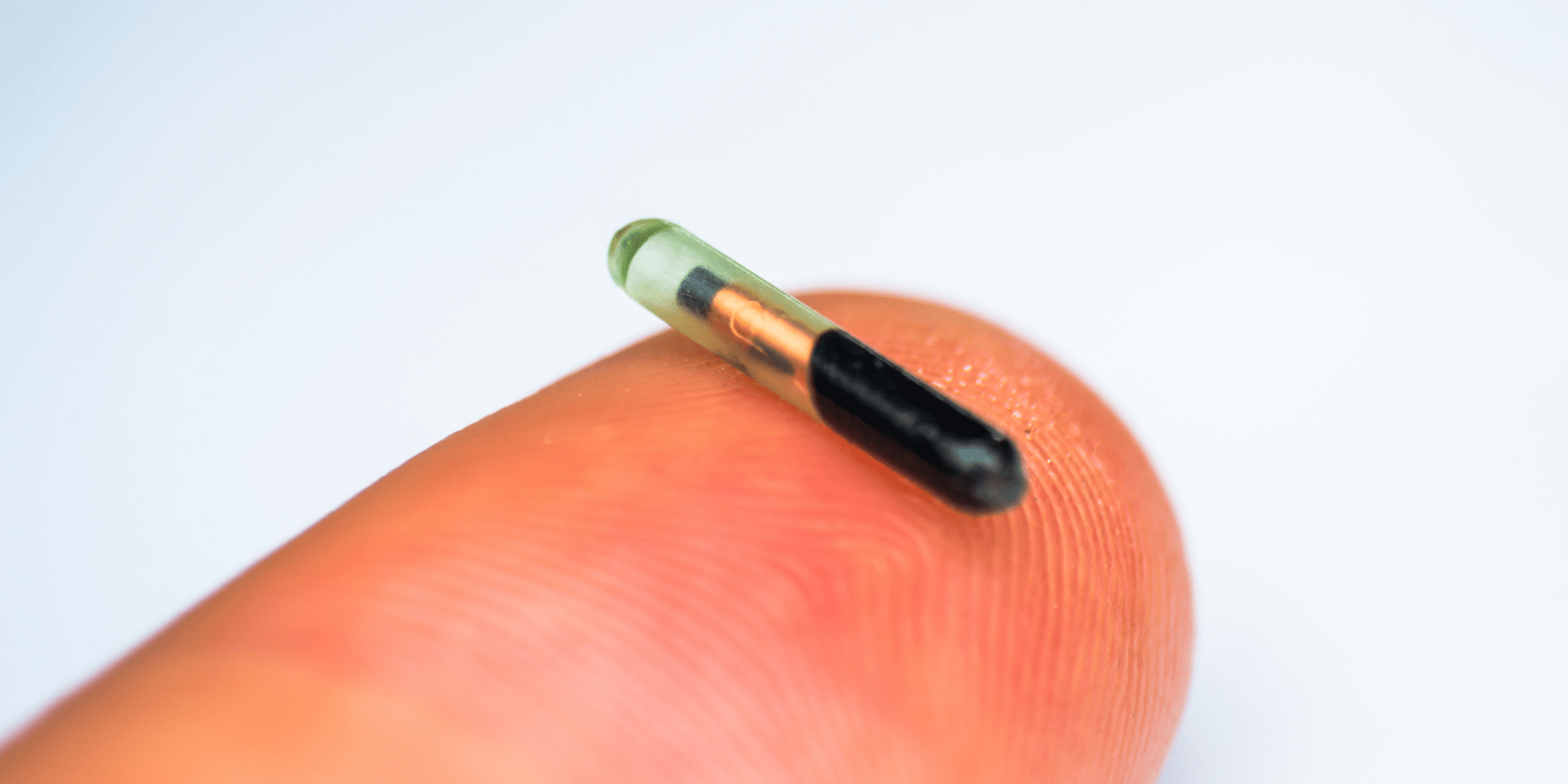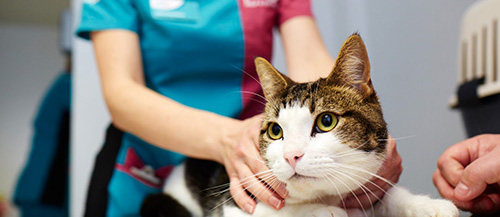Cat Microchipping
Overview
- A microchip is a tiny identification device that contains a unique number linking a pet to their owner.
- Microchips help reunite lost, stolen and injured pets with their owners as quickly as possible.
- Microchips in cats are implanted under the skin between the shoulder blades – it’s a very quick procedure that takes just a few seconds.
- It’s a legal requirement in England for all pet cats to be microchipped before they reach 20 weeks of age.

A microchip is a tiny identification device (the size of a grain of rice) that links a pet to their owner. Each microchip contains a unique number that can be read by a scanner. If your cat is microchipped and gets lost, anyone with a scanner (vets, dog wardens, and rescue centres) can scan them, call the microchip company and (if your contact details are up to date), get you reunited.
Cat microchips can also keep other cats out of your house if you have a microchip-activated cat flap, and restrict food access if you have a microchip food bowl.
Microchips are not linked to GPS and won’t track your cat’s location.
Cat microchip laws UK
- It’s a legal requirement for all pet cats in England to be microchipped by 20 weeks of age.
- This includes indoor-only cats.
- The law has been put in place to ensure lost, stolen, or injured cats have the best chance of being reunited with their owners as quickly as possible.
- If your cat is found to have no microchip, you will be given 21 days to have them microchipped or face a fine of up to £500.
- This law does not currently cover Wales, Scotland or Northern Ireland.
- We strongly recommend that all cats are microchipped before they start going outside.
- Microchipping is not compulsory for free living cats that live with little or no human interaction/dependency, such as farm, feral or community cats.

- Microchips can only be implanted by vets, veterinary nurses, and people who have been specially trained.
- Most owners get their cat microchipped at the vet’s, but if you go elsewhere (such as a rescue centre or grooming parlour) it’s important to make sure the person chipping your cat is qualified to do so.
- An ideal time to have your cat microchipped is when they are neutered - they will be under anaesthetic so won’t feel a thing!
- Your details will need to be registered with the microchip database company. They will need your name, address, phone number, pet’s details, and ideally an emergency contact.
Which database is my cat’s chip registered to?
- There are many different microchip database companies in the UK, it’s important that you make sure your cat is registered with one that’s UK Government approved.
- Use 'Check a Chip' to check which microchip database your pet is registered with.
Cost of microchipping your cat
- Microchipping usually costs between £10-30. Some vets include a microchip in their health plans, and some charities offer them for a reduced cost or for free.
- Some microchip database companies also offer an enhanced service for a small fee, which often includes unlimited personal detail changes, and assistance if your cat gets lost or stolen.
Changing ownership of a microchipped cat
- If you rehome or sell your cat, you’ll need to contact your microchip database company to let them know. They will give you a form or code to pass on to your cat’s new owner enabling them to change the details on the microchip. This process is designed to prevent people from changing a pet’s microchip details without the owner’s permission (i.e. if they were stolen).
Other pets
- It’s a legal requirement for all dogs in the UK over 8 weeks old to be microchipped. For more information, have a look at our article 'Microchipping your dog'.
- Although it’s not a legal requirement to have any other pets microchipped, we recommend you do. Rabbits, guinea pigs, ferrets, tortoises, and other small pets are notorious escape artists, so having them microchipped will help reunite you quickly if they go wandering.
- Even unusual pets like reptiles and birds can be microchipped – in fact it’s a requirement for some exotic species that fall under the Convention on International Trade in Endangered Species (CITES) rules.
- How do I change my microchip details?
- How would I find out if my cat is microchipped already?
- Does microchipping hurt?
- How long do microchips last?
- How long does it take to microchip a cat?
- Can you feel a microchip in a cat?
- Can you scan a cat microchip with your phone?
- Do I need to update my details when I move house?
- What happens if I don’t know my cat’s microchip number?
- Do I still need to microchip my indoor or elderly cat under the microchipping law in England?
- Who is going to enforce the cat microchipping law?
- Does the cat microchipping law include stray/feral cats?
- Do vets check microchips at every visit?
How do I change my microchip details?
If you need to change the contact details on your cat’s chip, such as your phone number or address, you’ll need to contact your microchip company directly. There may be a fee for this but sometimes you can pay a one-off fee that allows you to then make unlimited changes over the lifetime of your cat.
How would I find out if my cat is microchipped already?
If you are unsure whether your cat is microchipped and you do not have any microchip details on their vaccination card, contact your vet. They may have a record of your cat’s microchip on their file and if not, they will be able to scan your cat to check if it has a microchip.
Does microchipping hurt?
A microchip is implanted under a cat’s skin between their shoulder blades using a needle. Like any injection, microchipping can cause a tiny amount of discomfort but, fortunately, it’s a very quick procedure that takes just a few seconds. Most cats barely notice being microchipped, but a tasty treat afterwards is likely to quickly distract them if they do become upset.
Microchips are made out of non-reactive materials, so once it’s in place - it shouldn’t hurt or cause your cat any problems throughout their life.
How long do microchips last?
Microchips are hardwearing and should last for your cat's lifetime. It’s incredibly unusual for them to break or become faulty, but in the very rare case that one fails (meaning it can’t be read by a scanner anymore), the chip manufacturer will usually provide a replacement chip free of charge. There is no need to remove the old faulty chip, your vet can simply place the new chip in alongside it.
Much more commonly, microchips move a small distance away from where they are implanted but this doesn’t hurt, it very rarely causes problems and the chip will still be picked up if it’s scanned.
How long does it take to microchip a cat?
Microchipping is done by injection so takes just a few seconds. It can be done during a consult, or while your cat is under general anaesthetic for another procedure such as neutering.
Can you feel a microchip in a cat?
It is sometimes possible to feel microchips under the skin depending how deep they sit. Microchips sat right under the surface of the skin are much easier to feel than those sitting deeper under another layer of tissue.
Can you scan a cat microchip with your phone?
It’s not possible to scan microchips with a phone, but it is possible to buy a microchip scanner that you can link to your phone.
Do I need to update my details when I move house?
Yes, it is really important to make sure you update any details with the microchip company that have changed including phone number and address. Many cats are unfortunately not reunited with their owners due to forgetting to update details.
What happens if I don’t know my cat’s microchip number?
There may be a record of your cat’s microchip with their vaccination card. If not, you can phone your vet who may be able to let you know their chip number or you may need to bring your cat to the vet to have it scanned for a chip.
Do I still need to microchip my indoor or elderly cat under the microchipping law in England?
Yes, it is a legal requirement for all pet cats over 20 weeks old in England to be microchipped, including indoor and elderly cats. It’s important to make sure indoor cats have a microchip in case they ever manage to sneak out and get lost. It’s all too easy for a window or door to be accidentally left open, especially in the summer, and a microchip will help to ensure you can be reunited.
Who is going to enforce the cat microchipping law?
Local authorities will enforce the cat microchipping law.
Does the cat microchipping law include stray/feral cats?
Microchipping is not compulsory for free living cats that live with little or no human interaction/dependency, such as farm, feral or community cats.
Do vets check microchips at every visit?
It’s not a requirement for vets to check every cat for a chip at each visit, but they will always check for a chip before implanting another, or if a stray/lost cat is handed in.
If you find a cat you think may be stray or lost, contact your local vet to ask if they can scan them for a microchip. If you have lost your cat, get in touch with animal shelters and vet practices in your area, as well as alerting the microchip database they are registered to that they are lost.
Published: June 2024
Did you find this page useful?
Tell us more
Please note, our vets and nurses are unable to respond to questions via this form. If you are concerned about your pet’s health, please contact your vet directly.
Thank you for your feedback
Want to hear more about PDSA and get pet care tips from our vet experts?
Sign up to our e-newsletter
Written by vets and vet nurses. This advice is for UK pets only. Illustrations by Samantha Elmhurst.
